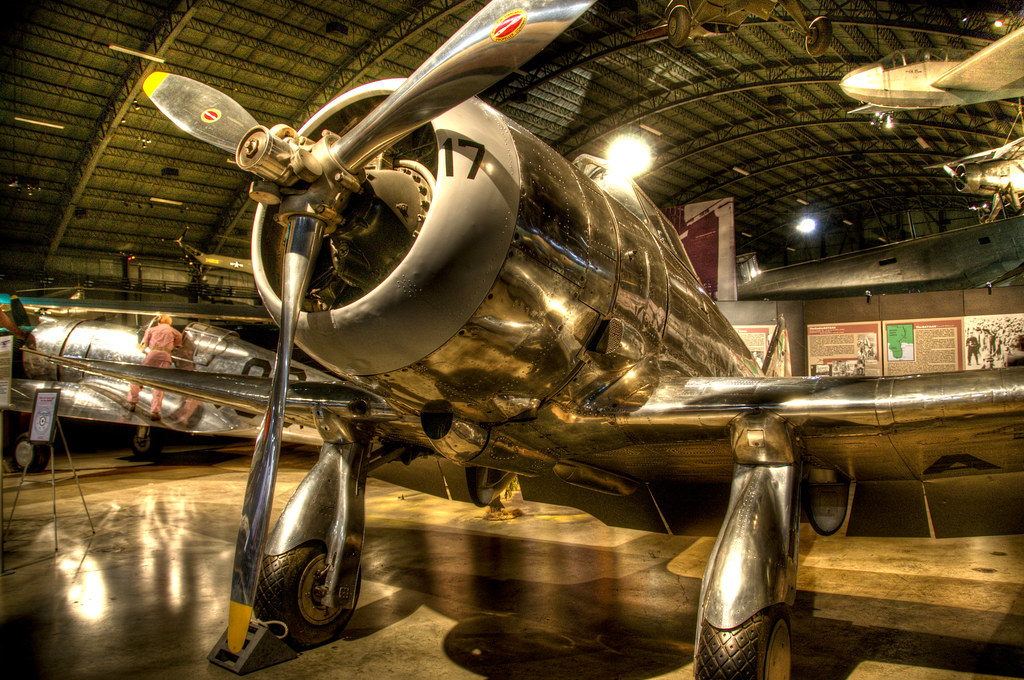
Republic P-47D (Bubble Canopy Version)
Renowned for its ruggedness, firepower and speed, the massive Republic P-47 was one of the most famous and important USAAF fighters during World War II. Produced in larger numbers than any other U.S. fighter, the Thunderbolt -- affectionately nicknamed the "Jug" -- served as a bomber escort and as a very effective ground attack fighter. The USAAF and several Allied nations used the P-47 in nearly every combat theater. Through 1943 in Europe, the P-47C and P-47D equipped the majority of 8th Air Force fighter groups in England (and one in the 15th Air Force in Italy) as a long-range escort fighter. But since they couldn't escort USAAF heavy bombers all the way to some targets, longer-ranged P-51 Mustangs gradually replaced them in the escort role (with the sole exception of the 56th Fighter Group). The rugged and heavily-armed P-47D proved to be ideal for ground attack, though, and it became the backbone of the fighter-bomber force in the 9th Air Force in western Europe and the 12th Air Force in southern Europe. In the Pacific, several 5th Air Force fighter groups flew the P-47D against Japanese air and ground forces in New Guinea and the Philippines in 1943-1944. Later, five groups in the 7th Air Force (and, in the closing weeks of the war, the 20th Air Force) flew the much longer-ranged P-47N as an escort fighter for B-29s against the Japanese homeland.

Bell P-63E Kingcobra
This World War II fighter was developed from the P-39 Airacobra, which it closely resembles. The U.S. Army Air Forces never used the P-63 in combat, although some were used for fighter training. Many P-63s were exported as lend-lease aircraft; the Soviet Union received 2,456 and Free French forces obtained 300. Since the P-63's low-level performance was adequate, it was widely used by the Soviets for such missions as "tank busting." Bell produced 3,305 P-63s, 13 of which were P-63Es.

Seversky P-35, Curtiss P-36A Hawk (background)
The P-35, a forerunner of the Republic P-47, was the U.S. Army Air Corps' (USAAC) first production single-seat, all-metal pursuit plane with retractable landing gear and an enclosed cockpit. The USAAC accepted 76 P-35s in 1937-1938, and assigned all but one of them to the 1st Pursuit Group at Selfridge Field, Mich.
The P-36, developed from the Curtiss Hawk Model 75 originally designed for France, was first produced for the Air Corps in 1938. The Army Air Corps obtained 243 P-46s, including 30 P-36G export models seized by the U.S. government in 1942 because of the German occupation of Norway. Both France and England used the Hawk 75A in combat over Europe in 1939 and 1940, even though the airplane was obsolescent when compared to its major adversary, the German Messerschmitt Bf 109. During 1941, the Air Corps transferred 39 of its P-36s to Hawaii and 20 to Alaska. After World War II began, the outmoded P-36 soon was relegated to training and courier duties within the United States.

No comments:
Post a Comment